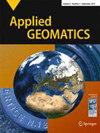Review of Remote Sensing Approaches and Soft Computing for Infrastructure Monitoring
IF 2.3
Q2 REMOTE SENSING
引用次数: 0
Abstract
During the past few decades, remote sensing has been established as an innovative, effective and cost-efficient option for the provision of high-quality information concerning infrastructure to governments or decision makers in order to update their plans and/or take actions towards the mitigation of the infrastructure risk. Meanwhile, climate change has emerged as a serious global challenge and hence there is an urgent need to develop reliable and cost-efficient infrastructure monitoring solutions. In this framework, the current study conducts a comprehensive review concerning the use of different remote-sensing sensors for the monitoring of multiple types of infrastructure including roads and railways, dams, bridges, archaeological sites and buildings. The aim of this contribution is to identify the best practices and processing methodologies for the comprehensive monitoring of critical national infrastructure falling under the research project named “PROION”. In light of this, the review summarizes the wide variety of approaches that have been utilized for the monitoring of infrastructure and are based on the collection of remote-sensing data, acquired using the global navigation satellite system (GNSS), synthetic aperture radar (SAR), light detection and ranging (LiDAR) and unmanned aerial vehicles (UAV) sensors. Moreover, great emphasis is given to the contribution of the state-of-the-art soft computing methods throughout infrastructure monitoring aiming to increase the automation of the procedure. The statistical analysis of the reviewing publications revealed that SARs and LiDARs are the prevalent remote-sensing sensors used in infrastructure monitoring concepts, while regarding the type of infrastructure, research is orientated onto transportation networks (road and railway) and bridges. Added to this, deep learning-, fuzzy logic- and expert-based approaches have gained ground in the field of infrastructure monitoring over the past few years.基础设施监测的遥感方法与软计算综述
在过去几十年中,遥感已成为向政府或决策者提供有关基础设施的高质量信息的一种创新、有效和具有成本效益的选择,以便更新其计划和(或)采取行动减轻基础设施风险。与此同时,气候变化已成为一项严重的全球挑战,因此迫切需要开发可靠且具有成本效益的基础设施监测解决方案。在这个框架内,本研究全面审查了使用不同的遥感传感器监测多种类型的基础设施,包括公路和铁路、水坝、桥梁、考古遗址和建筑物。这项贡献的目的是确定全面监测属于“PROION”研究项目的关键国家基础设施的最佳做法和处理方法。鉴于此,本综述总结了用于基础设施监测的各种方法,这些方法基于使用全球导航卫星系统(GNSS)、合成孔径雷达(SAR)、光探测和测距(LiDAR)和无人驾驶飞行器(UAV)传感器获得的遥感数据收集。此外,重点强调了在整个基础设施监测过程中最先进的软计算方法的贡献,旨在提高过程的自动化。对审查出版物的统计分析显示,sar和激光雷达是基础设施监测概念中普遍使用的遥感传感器,而关于基础设施的类型,研究面向交通网络(公路和铁路)和桥梁。除此之外,深度学习、模糊逻辑和基于专家的方法在过去几年里在基础设施监测领域取得了进展。
本文章由计算机程序翻译,如有差异,请以英文原文为准。
求助全文
约1分钟内获得全文
求助全文
来源期刊

Applied Geomatics
REMOTE SENSING-
CiteScore
5.40
自引率
3.70%
发文量
61
期刊介绍:
Applied Geomatics (AGMJ) is the official journal of SIFET the Italian Society of Photogrammetry and Topography and covers all aspects and information on scientific and technical advances in the geomatics sciences. The Journal publishes innovative contributions in geomatics applications ranging from the integration of instruments, methodologies and technologies and their use in the environmental sciences, engineering and other natural sciences.
The areas of interest include many research fields such as: remote sensing, close range and videometric photogrammetry, image analysis, digital mapping, land and geographic information systems, geographic information science, integrated geodesy, spatial data analysis, heritage recording; network adjustment and numerical processes. Furthermore, Applied Geomatics is open to articles from all areas of deformation measurements and analysis, structural engineering, mechanical engineering and all trends in earth and planetary survey science and space technology. The Journal also contains notices of conferences and international workshops, industry news, and information on new products. It provides a useful forum for professional and academic scientists involved in geomatics science and technology.
Information on Open Research Funding and Support may be found here: https://www.springernature.com/gp/open-research/institutional-agreements
 求助内容:
求助内容: 应助结果提醒方式:
应助结果提醒方式:


